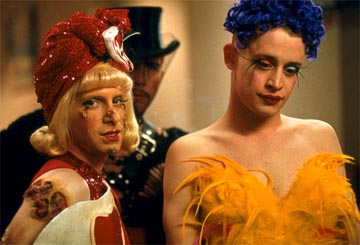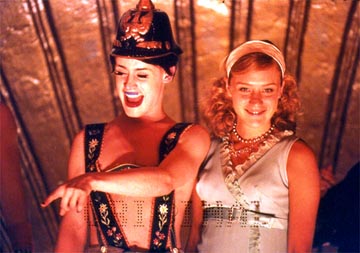

After failed outings in the horrible Richie Rich and The Pagemaster, Macaulay Culkin virtually vanished off the face of the earth. He was a child actor who was turning into a man, and nobody seemed to care. Everybody still thought of him as the cute kid from Home Alone who screamed and slapped his hands to his cheeks. While he was off doing whatever it was he was doing (partially dealing with his parents' bitter divorce), anybody who missed him could watch his brother/clone Kieran. Then, Kieran, unlike Macaulay, started maturing as an actor, so anybody who wanted to see a younger Macaulay could watch yet another brother/clone, Rory. So now, nearly a decade later, Macaulay wants to get into acting. What is a boy to do? Well, do something as far as possible from what people associate him with, to somehow prove his merit as an actor, and this is where Party Monster comes in. In this film, Culkin plays Michael Alig, a bisexual, drug-addled, self-promoting party child who is currently in jail for murder.
Party Monster is based on the novel Disco Bloodbath by James St. James, himself another so-called "Club Kid." These kids rose to fame in New York beginning in the late 80s as flamboyant party animals who organized wild parties. They were extremely gifted at self-promotion and hype, but led a destructive lifestyle that could only end up in one place. Co-adapters/co-directors Fenton Bailey and Randy Barbato (101 Rent Boys, The Eyes of Tammy Faye) already made a documentary on Alig also called Party Monster, and why they chose to revisit events in a fictional manner remains something of a mystery, especially given how the movie turned out. The new Party Monster is a fairly straightforward telling of Alig's life as soon as he came to New York. He was from the mid-West but didn't fit in at all, and once he met St. James (Seth Green, Austin Powers in Goldmember, Knockaround Guys), he instantly latched onto him and started imitating him. This meant a steady diet of drugs, and dressing in the strangest costumes imaginable. Once he realized he could start an industry on himself and his image, he convinced club owner Peter Gatien (Dylan McDermott, Texas Rangers, Three to Tango) to help create some parties.
The issue with Party Monster is, that in a film full of drugs, partying, sex and booze, everything comes across as pretty dull. In real life, Alig had to be a charismatic figure to draw so many people to him. He did do some pretty outrageous things chronicled in the film, like bringing a party to a fast food restaurant or the back of a big rig. He tried to make sure that every costume he had was more outrageous than the last. Yet Bailey and Barbato completely neglect his powers of persuasiveness and choose to focus on the feebler elements of Alig. He was most certainly a lonely kid trying to fit in. A lot of what he did was some strange cry for attention. And what better way to draw attention to oneself than to wear a dress soaked with fake blood. Culkin's portrayal of Alig is that of a pathetic, whiny loser, which he undoubtedly was, but it is bereft of life. He speaks in a weird, nasally staccato tone that succeeds in making him look very weird, and not much else. It's not a great showcase for a magnificent return to the screen. Green manages to outshine his co-star. His portrayal is equally flamboyant, yet there is a sense of humanity and realism to St. James. If Culkin and the script added this element to the Alig character, it would make his eventual murder of dealer Angel (Wilson Cruz, Supernova, All Over Me) that much more horrifying.
As it stands, Party Monster drones on endlessly, alternating between scenes of loud, raucous parties and slow scenes of Green and Culkin doing drugs. Chloe Sevigny (A Map of the World, Boy's Don't Cry) shows up as a groupie who eventually joins up with Alig, but she is merely a blip. As is Marilyn Manson (Jawbreaker, Lost Highway) who is completely unrecognizable in drag. Bailey and Barbato do manage to show how empty the lives of these Club Kids are, and how far gone Alig is by the time the events of the murder role around, but getting to this point is tedious. There are basically two ways to feel about Alig at the end of the film. One is a profound sense of sadness that a young boy wasted his life and turned into this, and the second is a smug sense of victory in watching Alig get what he deserved. It's too bad that, by the end of the film, the viewer doesn't really care one way or another.